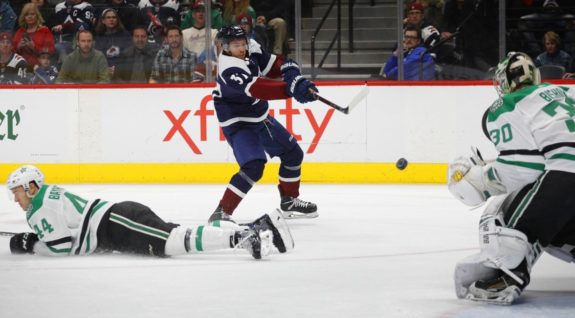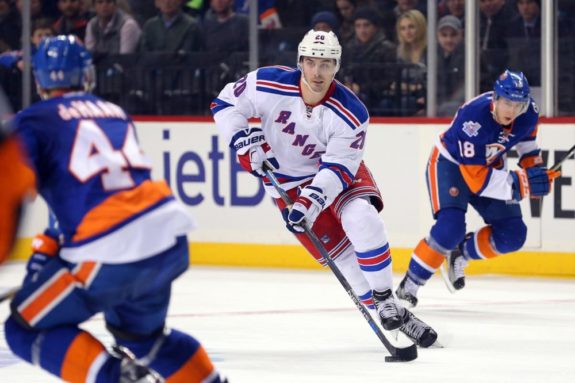The Colorado Avalanche snapped out of their recent funk on Friday night, slapping the New York Rangers 6-1 on home ice. The lopsided victory ended the Avs’ six-game losing streak and was just their third win in the last 13 games.
Leading the way were the usual suspects. Nathan MacKinnon and Mikko Rantanen each recorded three points, linemate and captain Gabriel Landeskog had a goal and an assist, and defenseman Tyson Barrie chipped in with helpers on three power-play goals.
Barrie eclipsed John-Michael Liles for the most points among defensemen in Avalanche franchise history which was a noteworthy moment, as was 23-year-old rookie Ryan Graves scoring his first career National Hockey League goal. However, I want to highlight the early third-period goal from the Avs’ second line of J.T. Compher, Tyson Jost, and Alexander Kerfoot:
Kerfoot’s deflection just barely squeaked by Rangers goaltender Alexander Georgiev, which is the perfect metaphor for how these three have been faring offensively this season: just barely good enough, which simply won’t cut it when the playoff race heats up in the coming months.
While these three youngsters have shown some level of promise this season, if the Avalanche want to make some noise this spring (and beyond), management will have to be proactive and make a move or two to acquire more scoring, instead of waiting for those three to reach their potential.
Avs Couldn’t Bury Chances During Losing Streak
Before we get to discussing the second line, let’s revisit the Avalanche’s ugly 2-7-3 stretch (before Friday’s win).
A main reason for the slump was their power play, which operated near the league average, at 18.9 per cent (10-for-53). In their previous 12 games, the team was 9-1-2 with a power play that operated at 40 per cent (14-for-35). However, that is only a difference of four goals over a 12-game stretch. So, why all the losses?
On the offensive side of things, the Avalanche created roughly the same amount of chances at even strength during both their 2-7-3 stretch and their 9-1-2 stretch. The difference? Their ability to finish.
| GF | SCF | SCGF | HDCF | HDGF | SH% | |
| 2-7-3 stretch (Dec. 8-Jan. 3) | 21 | 293 | 19 | 118 | 14 | 6.62 |
| 9-1-2 stretch (Nov. 14-Dec. 6) | 30 | 290 | 22 | 118 | 15 | 8.9 |
I prefer to use Scoring Chances (SCF) and High Danger Chances (HDCF) as opposed to shots on goal because it takes into account hitting posts and crossbars (technically not a shot) and discounts perimeter shots. This paints a more accurate picture.
Looking at the chart above, it’s clear the Avalanche didn’t have trouble creating offensive chances during their tough 2-7-3 stretch. Their 293 SCF during that period ranked fifth in the NHL. They created the exact same number of HDCF in both 12-game stretches, but failed to capitalize. Their 6.62 shooting percentage (SH%) was the third-worst in the league during that span. During their 9-1-2 stretch, their SH% of 8.9 was average, ranking 14th league-wide.
Now, back to Compher, Jost, and Kerfoot.

It’s clear the Avalanche had trouble burying their chances as a team, here’s a look at which players had the most trouble. First thing is first: it was not the top line that struggled (surprise, surprise).
During the 9-1-2 stretch, the trio of MacKinnon, Rantanen, and Landeskog scored nine even-strength goals on 81 scoring chances, for a conversion rate of 11.1 per cent (I prefer to use goals per scoring chance instead of shooting percentage when it comes to individual stats). During the club’s 2-7-3 stretch, their conversion rate was basically the same, at 10.7 per cent (eight goals on 75 scoring chances).
If it wasn’t the top line, who struggled offensively when the Avs were losing?
| 2-7-3 Stretch | Goals | iSCF | Rate | iHDCF |
| Alex Kerfoot | 1 | 14 | 7.1% | 6 |
| J.T. Compher | 1 | 18 | 5.6% | 11 |
| Tyson Jost | 1 | 15 | 6.7% | 7 |
| Carl Soderberg | 0 | 25 | 0% | 14 |
| Matt Nieto | 0 | 23 | 0% | 9 |
| Matt Calvert | 3 | 25 | 12% | 9 |
| Sven Andrighetto | 1 | 13 | 7.7% | 3 |
| Colin Wilson | 0 | 8 | 0 | 3 |
| TOTAL | 7 | 141 | 4.9% | 62 |
The ugly 4.9 per cent conversion rate among the team’s remaining forwards is not good. Remember, the top line’s rate was 10.7 per cent during the 2-7-3 stretch. Soderberg’s zero goals on 25 individual scoring chances (iSCF) and Nieto’s zero goals on 23 chances are particularly cringe-worthy, while Matt Calvert’s three goals on 25 chances is a surprising positive. But we aren’t here to discuss the bottom-six forwards. Soderberg, Nieto and co. aren’t expected to score. When they do, it’s a bonus. What’s concerning is Compher, Jost, and Kerfoot’s combined three goals on 47 iSCF (6.4 per cent).
What’s even more concerning is the trio had an even worse conversion rate during the 9-1-2 stretch.
| 9-1-2 Stretch | Goals | iSCF | Rate | iHDCF |
| Kerfoot | 0 | 10 | 0% | 3 |
| Compher | 2 | 14 | 14.3% | 10 |
| Jost | 0 | 17 | 0% | 6 |
| Soderberg | 3 | 20 | 15% | 10 |
| Nieto | 1 | 7 | 14.3% | 4 |
| Calvert | 2 | 24 | 8.3% | 10 |
| Sven | 1 | 11 | 9.1% | 4 |
| Wilson | 2 | 12 | 16.7% | 6 |
| TOTAL | 11 | 115 | 9.6% | 53 |
Compher, Jost, and Kerfoot scored a combined two even-strength goals on 41 iSCF (4.9 per cent) when the team was winning (a lot). If you combine the two 12-game stretches, the trio has converted five times on 88 scoring chances over the past 24 games (not including Friday’s win), for a 5.9 per cent conversion rate. That is nowhere close to good enough.
Don’t Trade Compher, Jost or Kerfoot
While I am arguing that Compher, Jost, and Kerfoot have not done enough this season offensively, I am not saying the Avalanche should trade any of them.

All three are 24 or younger, all three made it to the NHL despite doubts about their size, and all three bring something different to the table. Compher can kill penalties, has a deceptively strong shot, and has improved on face-offs. Jost is responsible defensively, has a high hockey IQ and works well on the cycle. Kerfoot is blindingly fast, creative with the puck, and a Grade-A passer. The issue is Kerfoot needs better finishers to play with on the second line. Right now, that is not Compher or Jost.
Forward Trade Targets For the Avs in the East?
With the trade deadline now under two months away, it might be time to explore who the Avalanche should target for additional scoring depth. Someone like Chris Kreider or Ryan Dzingel would go a long way.

They each have 13 even-strength goals this year and are just outside the top-50 in the league in individual HDCF. That means a) they can finish and b) they get a lot of chances.
They are both on rebuilding teams and don’t bring large financial commitments with them. Kreider has one year left with a $4.625 million cap hit while Dzingel is an upcoming Unrestricted Free Agent (UFA) making just $1.8 million this season, meaning the Avalanche wouldn’t be tied to either long-term if a move doesn’t pan out.
If the Avalanche don’t acquire scoring help at this year’s deadline, they may live and die by their top line. If I’m general manager Joe Sakic, I’m not okay with that. And fans shouldn’t be okay with that either.
All advanced stats used in this piece courtesy Natural Stat Trick.